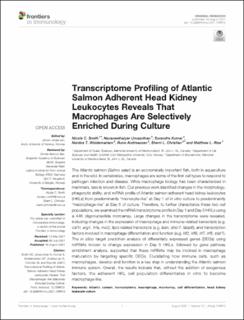| dc.contributor.author | Smith, Nicole | |
| dc.contributor.author | Umasuthan, Navaneethaiyer | |
| dc.contributor.author | Kumar, Surendra | |
| dc.contributor.author | Woldemariam, Nardos Tesfaye | |
| dc.contributor.author | Andreassen, Rune | |
| dc.contributor.author | Christian, Sherri | |
| dc.contributor.author | Rise, Matthew L. | |
| dc.date.accessioned | 2021-10-07T10:25:29Z | |
| dc.date.available | 2021-10-07T10:25:29Z | |
| dc.date.created | 2021-09-06T16:44:08Z | |
| dc.date.issued | 2021-08-16 | |
| dc.identifier.issn | 1664-3224 | |
| dc.identifier.uri | https://hdl.handle.net/11250/2788354 | |
| dc.description.abstract | The Atlantic salmon (Salmo salar) is an economically important fish, both in aquaculture and in the wild. In vertebrates, macrophages are some of the first cell types to respond to pathogen infection and disease. While macrophage biology has been characterized in mammals, less is known in fish. Our previous work identified changes in the morphology, phagocytic ability, and miRNA profile of Atlantic salmon adherent head kidney leukocytes (HKLs) from predominantly “monocyte-like” at Day 1 of in vitro culture to predominantly “macrophage-like” at Day 5 of culture. Therefore, to further characterize these two cell populations, we examined the mRNA transcriptome profile in Day 1 and Day 5 HKLs using a 44K oligonucleotide microarray. Large changes in the transcriptome were revealed, including changes in the expression of macrophage and immune-related transcripts (e.g. csf1r, arg1, tnfa, mx2), lipid-related transcripts (e.g. fasn, dhcr7, fabp6), and transcription factors involved in macrophage differentiation and function (e.g. klf2, klf9, irf7, irf8, stat1). The in silico target prediction analysis of differentially expressed genes (DEGs) using miRNAs known to change expression in Day 5 HKLs, followed by gene pathway enrichment analysis, supported that these miRNAs may be involved in macrophage maturation by targeting specific DEGs. Elucidating how immune cells, such as macrophages, develop and function is a key step in understanding the Atlantic salmon immune system. Overall, the results indicate that, without the addition of exogenous factors, the adherent HKL cell population differentiates in vitro to become macrophage-like. | en_US |
| dc.description.sponsorship | This study was funded by Natural Sciences and Engineering Research Council of Canada (NSERC) Discovery Grants to MR (341304-2012 and 2020-04519), a Memorial University of Newfoundland Seed grant to SC (212779), a NSERC Discovery Grant to SC (2017-04630), a Norwegian Research Council grant to RA (280839/E40), and Genomic Applications Partnership Program projects [GAPP # 6604: Biomarker Platform for Commercial Aquaculture Feed Development project; and GAPP #6607: Integrated Pathogen Management of Co-infection in Atlantic salmon (IPMC) project] funded by the Government of Canada through Genome Canada and Genome Atlantic, and Cargill Innovation (formerly EWOS Innovation) to MR. The IPMC project was also funded by the Government of Newfoundland and Labrador through the Department of Tourism, Culture, Industry and Innovation (Leverage R&D award #5401-1019-108. NS was supported by a NSERC PGS D fellowship. | en_US |
| dc.language.iso | eng | en_US |
| dc.publisher | Frontiers Media | en_US |
| dc.relation.ispartofseries | Frontiers in Immunology;August 2021 | Volume 12 | Article 709910 | |
| dc.rights | Navngivelse 4.0 Internasjonal | * |
| dc.rights.uri | http://creativecommons.org/licenses/by/4.0/deed.no | * |
| dc.subject | Atlantic salmon | en_US |
| dc.subject | Transcriptomes | en_US |
| dc.subject | Macrophages | en_US |
| dc.subject | Microarrays | en_US |
| dc.subject | Cell differentiations | en_US |
| dc.subject | Head kidney leukocyte cultures | en_US |
| dc.title | Transcriptome Profiling of Atlantic Salmon Adherent Head Kidney Leukocytes Reveals That Macrophages Are Selectively Enriched During Culture | en_US |
| dc.type | Peer reviewed | en_US |
| dc.type | Journal article | en_US |
| dc.description.version | publishedVersion | en_US |
| dc.rights.holder | Copyright © 2021 Smith, Umasuthan, Kumar, Woldemariam, Andreassen, Christian and Rise. | en_US |
| dc.source.articlenumber | 709910 | en_US |
| cristin.ispublished | true | |
| cristin.fulltext | original | |
| cristin.qualitycode | 1 | |
| dc.identifier.doi | https://doi.org/10.3389/fimmu.2021.709910 | |
| dc.identifier.cristin | 1931751 | |
| dc.source.journal | Frontiers in Immunology | en_US |
| dc.source.volume | 12 | en_US |
| dc.source.pagenumber | 1-19 | en_US |
| dc.relation.project | Norges forskningsråd: 280839 | en_US |

